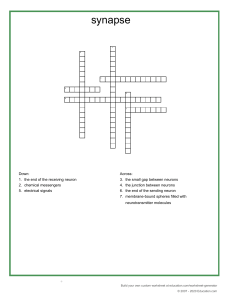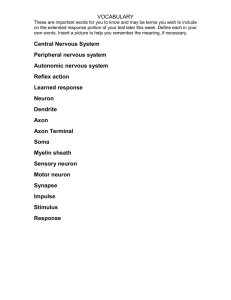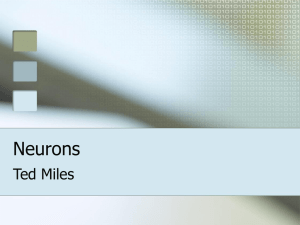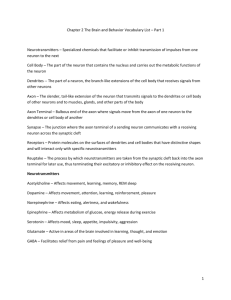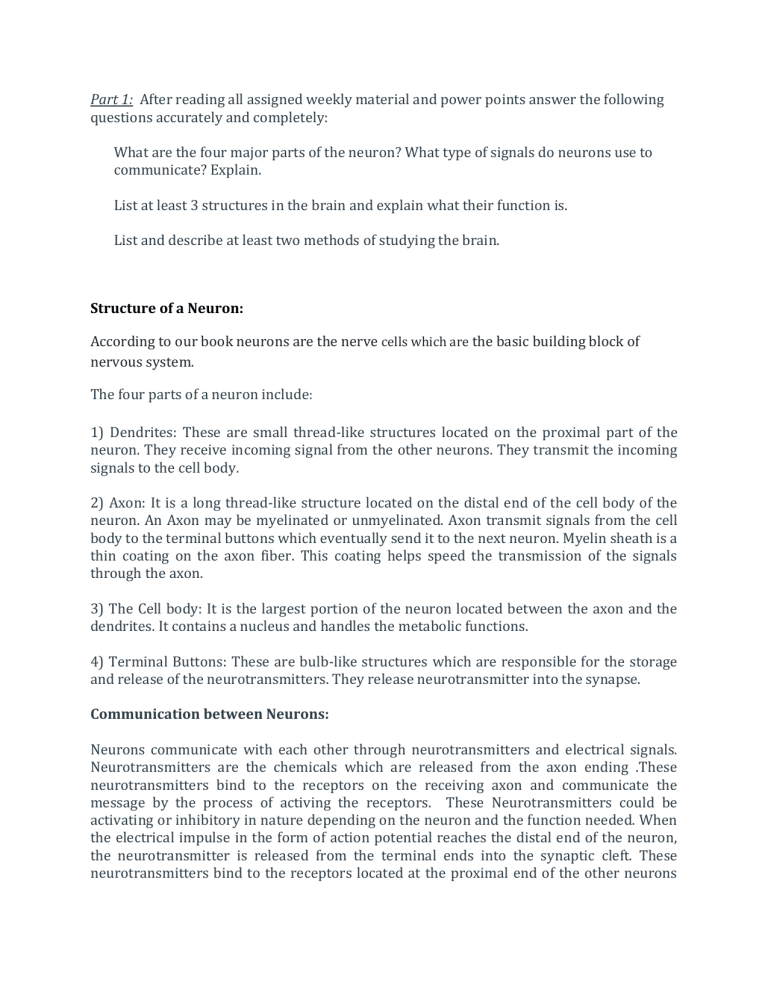
Part 1: After reading all assigned weekly material and power points answer the following questions accurately and completely: What are the four major parts of the neuron? What type of signals do neurons use to communicate? Explain. List at least 3 structures in the brain and explain what their function is. List and describe at least two methods of studying the brain. Structure of a Neuron: According to our book neurons are the nerve cells which are the basic building block of nervous system. The four parts of a neuron include: 1) Dendrites: These are small thread-like structures located on the proximal part of the neuron. They receive incoming signal from the other neurons. They transmit the incoming signals to the cell body. 2) Axon: It is a long thread-like structure located on the distal end of the cell body of the neuron. An Axon may be myelinated or unmyelinated. Axon transmit signals from the cell body to the terminal buttons which eventually send it to the next neuron. Myelin sheath is a thin coating on the axon fiber. This coating helps speed the transmission of the signals through the axon. 3) The Cell body: It is the largest portion of the neuron located between the axon and the dendrites. It contains a nucleus and handles the metabolic functions. 4) Terminal Buttons: These are bulb-like structures which are responsible for the storage and release of the neurotransmitters. They release neurotransmitter into the synapse. Communication between Neurons: Neurons communicate with each other through neurotransmitters and electrical signals. Neurotransmitters are the chemicals which are released from the axon ending .These neurotransmitters bind to the receptors on the receiving axon and communicate the message by the process of activing the receptors. These Neurotransmitters could be activating or inhibitory in nature depending on the neuron and the function needed. When the electrical impulse in the form of action potential reaches the distal end of the neuron, the neurotransmitter is released from the terminal ends into the synaptic cleft. These neurotransmitters bind to the receptors located at the proximal end of the other neurons called dendrites and stimulate various channels creating a positive charge in the next neuron called action potential. The type of signals might be a reflex action for example withdrawal of hand after touching the hot object. Other signal or messages may include pain conduction, temperature conduction, fear response and so on. Structures in the Brain: Our Brian has many different structures which have their own sophisticated roles and importance. For the purpose of this assignment, I will discuss following three structures: 1) Cerebellum: It controls balance .Movement and coordination. Cerebellum is located in the lower part of the brain just beside the brain stem. It consists of a network of fibers. It receives in formation from various parts including the sensory system, spinal cord and other parts of the brain. Any Damage to the cerebellum could result in difficulties in balance, coordination and movement and termers in various parts of the body. 2) Medulla Oblongata: It is a long stem like structure located in the brain stem. Its location is just adjacent to the cerebellum. It is an extremely important structure which controls vital functions like heartbeat and respiration. Damage to the brain stem can result in sudden death. 3) Cerebral cortex: controls executive functioning and judgment. It is the most advanced part of the brain and the last one to develop. It is divided into different lobes which perform their own functions including speech, movement, vision, abstract thinking, judgement, impulse control and so on. Major Methods of Studying Brian: There are various methods which have been used over the history to study our brain. However, for the purpose of this assignment, I will be discussing two major methods which are most commonly used in the current world. These methods include: 1) Imaging and radiological studies 2) Clinical or damage/ lesion studies 1) Image studies include various radiological techniques to study the brain and determine causes of various neurological conditions. These studies include CT-Scans which are most commonly used to determine bleeding in the brain. MRI is more advanced and helps determine the strokes, white and gray matter lesions and tumors. Functional MRI help determine which part of the brain is active in the performance of certain activities. 2) Clinical or damage/ lesion studies : Lesion/Damage studies are more clinical. Physician with knowledge of functions of the various area of the brain determine the area of brain effecting loss of certain function of the patient. These studies and experiment help us to determine what functions are lost if a certain part of the brain is damaged. Part 2: After watching the Documentary, Nova: Secret of the Wild Child (link below and in Ch. 4 power point), answer the following questions accurately and completely: Do you think the story of Genie shows the influence of “nature” (e.g., genes, biology) or “nurture” (e.g., environment, social roles) on development? Why? Use examples from the documentary to answer this question. I believe the story of genie shows the influence of nurture which means that the environment and experience help develop certain skills in the child. The child in the documentary was isolated for a very long period of time from the world. This isolation deprived her from many important experiences which she would have had if she was given the environment with more opportunities to experience new things and new surroundings. New experience increase learning in the child and also lead to the development of the adaptive behaviors. More language and communication help increase the vocabulary of the child and help in the development of the speech areas in our brain. These areas in the brain continue to develop as the child grows in age and experience. Unfortunately, the child in the documentary was deprived of these experiences due to the isolations and it caused her to lack various skills which other children of her age develop. She was raised in the environment of isolation, deprivation, fear and punishment. All of these are well known to cause major impact of the development of the children. Does the story of Genie support the idea that children have a "critical period" for developing language? Why or Why Not? Use examples from the documentary to answer this question. (If you are confused by the critical period hypothesis, please look at the Ch. 4 power point). Language development does have a critical period. Speech centers in our brain develop in the first few years of our life. If no speech is directed to these areas then the development of these areas does not happen appropriately. This can result in lack of speech or delays in the development of the speech. This is one of the reasons why doctors order hearing test for children in the earlier stages of their life because if the child is not hearing properly then the speech is delayed. The extent of language and vocabulary is also dependent of the amount of the speech directed to the child. More verbal communication with the child results in better development of the speech. Children who are deprived of these experience result in speech delays and lack of language development. This was also seen in the examples given in the documentary. Due to the isolation and lack of exposure to the language and communication, the speech difficulties are appreciated. Was Genie treated ethically by the scientists she encountered? Why or Why not? Use examples from the documentary to answer this question. It is a little difficult to decide in black and white, if Genies was treated ethically or not. In my view, Genie was an unfortunate child suffering from severe physical and psychological abuse from her bio dad. The child was severely deprived. When she was discovered to the world, she was seen as an experiment object. The child received attention and care she deserved like any other child. This did help her improve and gain more skills. Her behaviors did improve with the consistency of care and environment. However, the question is about the motive of the people who cared for her. Was she just an experimental object or she was a real family member? This is a hard question to answer. If she was treated like a true family member, then why was she abandoned and sent to a group home when the research funding was depleted. The people involved in her care received monetary and academic benefits by caring for her. Ethically, they owe her a responsibility to provide care for rest of her life. She should have been treated the way any other child would have been treated. This is where things do appear unethical because she was just abandoned after the research was over. In conclusion, I will say that although Genie did get some benefits but overall based on my experience of the story, Gene was exploited. This is unethical in my view.
